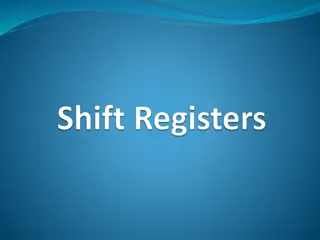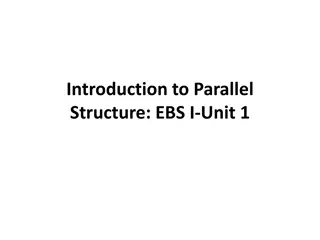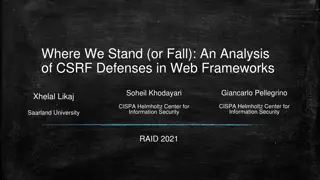Understanding Data Parallel Frameworks in Web-Scale Applications
Explore the intricacies of data parallel frameworks in web-scale apps, hosted on massive computing infrastructures. Learn about the types of data stored, how it is utilized (including big data concepts), and the challenges and requirements of data analytics in such environments. Dive into examples illustrating data collection, storage, analytics, and serving processes.
- Data parallel frameworks
- Web-scale applications
- Big data analytics
- Computing infrastructures
- Data storage
Download Presentation

Please find below an Image/Link to download the presentation.
The content on the website is provided AS IS for your information and personal use only. It may not be sold, licensed, or shared on other websites without obtaining consent from the author. Download presentation by click this link. If you encounter any issues during the download, it is possible that the publisher has removed the file from their server.
E N D
Presentation Transcript
Data Parallel Frameworks Ashvin Goel Electrical and Computer Engineering University of Toronto ECE 1724 Some of these slides are heavily modified slides from Prof. Ken Birman s course on Cloud Computing 1
What are Web-Scale Apps? Applications that are hosted in massive-scale computing infrastructures such as data centers Used by millions of geographically distributed users Via web browsers, mobile clients, etc. Produce, store, consume massive amounts of data Scale is hard to comprehend 2
What Kind of Data is Stored? Companies store data based on their business model Google, e.g., daily snapshot of all the web pages in the world Amazon, e.g., current product data & price for every product Facebook, e.g., social networking graph We have seen various types of storage systems for storing this data Data is typically sharded across many machines Sharded data is replicated for fault tolerance, fast read access Much focus on scalability, data availability, consistency, etc. 3
How is the Data Used? i.e, What is Big Data ? Web search (e.g., Google) needs to analyze billions of web pages to determine the most relevant pages Product search (e.g., Amazon) needs to analyze millions of products, who bought them, their reviews, etc. Recommendation systems (e.g., LinkedIn, Facebooks) need to analyze massive social graphs All the above can be used to generate massive revenue streams, e.g., smart ad placement, recommendations These are restaurants you might like based on your tastes These stores have big Christmas sales for things you like 4
A Simple Example: Web Search Data collection and storage Collect web pages, store them Data analytics Extract words (or phases) from web pages Associate each word with a ranked list of web pages that contain these words Data serving When user searches for word, serve associated list of pages 5
Data Analytics Requirements Data analytics Extract words (or phases) from web pages Associate each word with a ranked list of web pages that contain these words Massive computation needs Parse all pages Rank all pages, similar to sorting a very large data set E.g., find the most authoritative pages by organizing web pages in a graph, then finding the graph nodes with highest weight (rank) 6
Data Analytics Challenges Data is massive Need sharding across large numbers of machines Need storage on disk Need to handle storage failures Need to handle updates (later) Computation is massive Need scalable, parallel computation models Need to handle massive intermediate, final results Need to handle compute failures 7
http://www.cs.cornell.edu/courses/cs5412/2018sp 8 Data Analytics Frameworks These frameworks perform massively parallel ( always sharded ) computing efficiently The data starts out sharded Often the intermediary states and results are sharded Final results are some human-useful output, e.g., charts 8
A Typical Big Data System Batch Processing Analytical SQL Stream Processing Machine Learning Other Applications Resource Manager (Workload Manager, Task Scheduler) Data Storage (File System, Database) 9
Open-Source Apache Ecosystem Apache Hadoop, Spark Spark MLlib Spark Streaming Other Apps Hive Resource Manager (YARN, Mesos) Hadoop NoSQL (Hbase) Hadoop Distributed File System (HDFS) 10
Data Ingestion Apache Hadoop, Spark Spark MLlib Other Apps Spark Streaming Hive Resource Manager (YARN, Mesos) Data Ingest Systems e.g., Kafka, Flume Hadoop NoSQL (Hbase) Hadoop Distributed File System (HDFS) 11
Coordination Apache Hadoop, Spark Spark MLlib Spark Streaming Other Apps Hive Zookeeper Apache Resource Manager (YARN, Mesos) Hadoop NoSQL (Hbase) Hadoop Distributed File System (HDFS) 12
Batch Processing Frameworks Focus on simplifying the complexity of distributed programming Developer focuses on logic for processing data Framework takes care of parallelization, fault tolerance, scheduling, caching, Hadoop (MapReduce) Suited for individual batch (long running) jobs Spark Also suited for iterative and interactive batch jobs 13
Map Reduce MapReduce enables distributing (parallelizing) a job across multiple nodes of a cluster Allows programmers to describe processing in terms of simple map and reduce functions on items Framework takes care of scaling, scheduling, hardware and software failures 15
16 Spark Same goal as Map Reduce, i.e., enable distributing (parallelizing) a job across multiple nodes of a cluster Allows programmers to describe processing in terms of transformations on fault-tolerant, distributed datasets Datasets are nodes, transformations are edges in a graph Transformations are evaluated only when needed (lazily) Framework takes care of caching, data locality, scaling, scheduling, hardware and software failures Keep idea is to cache intermediate data that is reused 16
Challenges Parallelization Fault tolerance 17
18 Parallelization Key intuition Often same processing is required for all items Processing is independent for each item E.g., update count of the # of accesses to each website Same operation is performed for each website Operation (e.g., map) can be performed in parallel Similar to a SIMD instruction However, operation works on shards on different machines Produces intermediate data that is also sharded across machines 18
19 Why Batching? Shards are typically large, e.g., 16-64MB Batch processing, i.e., processing all the data in a shard amortizes processing costs Cost of processing each item is typically low, e.g., count++ Cost of accessing each item from storage is high Batching reduces the latter cost However, batching requires enough data (updates) to be available, so trades latency for efficiency 19
Fault Tolerance Why is it really important for large computations? Aim is to hide failures from applications Provide behavior equivalent to fail-free operation Sometimes described in terms of exactly-once operation Both Map Reduce and Spark provide strong fault tolerance guarantees Their behavior is equivalent to running a sequential computation, even in the presence of failures We will discuss their fault tolerance techniques in detail 20























